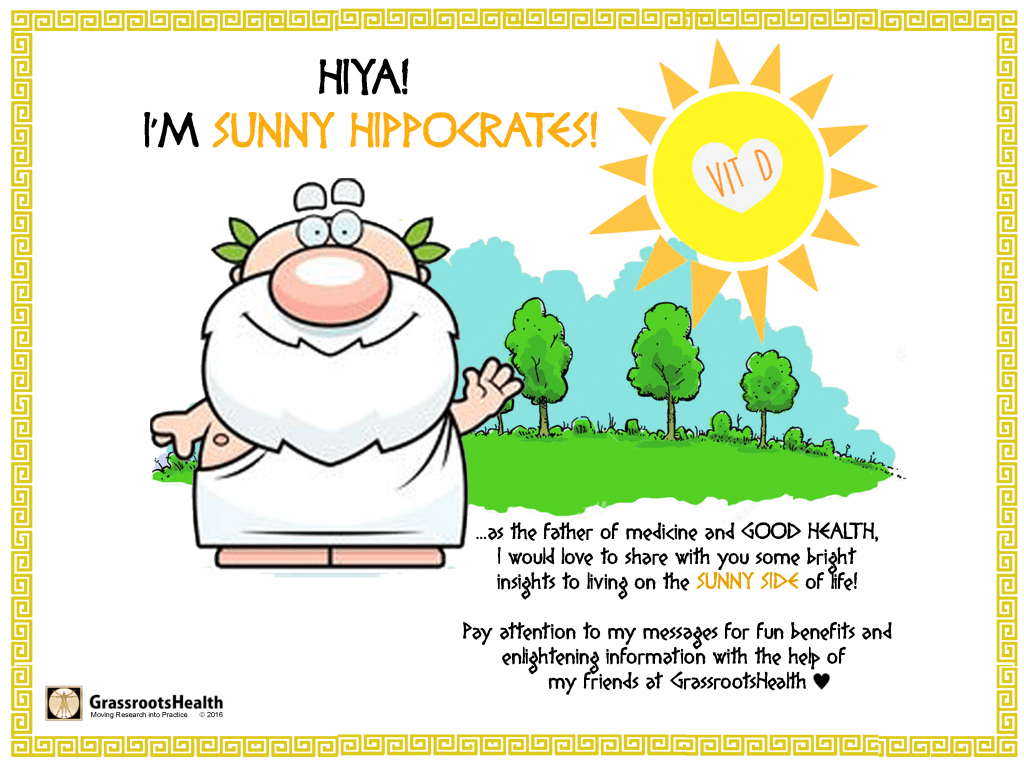Published on May 24, 2017
What is a minimum erythema dose?
An “erythema dose” is used by doctors to define the amount of ultraviolet radiation, from the sun or ultraviolet lamp, which results in a reddening of the skin. A minimal erythema dose is defined by a pinkness of the skin about 1-6 hours after sun exposure, going away within 24 hours. Sunny Hippocrates, our sunshine cartoon mascot, says to get no more than a *smidge* pink. There is no single erythema dose or sun exposure time recommendation, due in part to differences in skin type and other individual differences in vitamin D production, but one minimal erythema dose is equivalent to roughly 10,000 – 25,000 IU of supplemental vitamin D.
 Click to see more Sunny Hippocrates
Click to see more Sunny Hippocrates
The American Cancer Society (ACS) has extensive information on skin cancers and melanoma. ACS reports about 3.3 million Americans are diagnosed with basal or squamous cell skin cancer each year, with approximately 80% of diagnoses being for basal cell cancer. Only about 1% of all skin cancers are melanoma.
“Basal cell and squamous cell skin cancer: These cancers are most often found in areas exposed to the sun, such as the head, neck, and arms, but they also can occur elsewhere. They are very common but are also usually very treatable.” – ACS website
Basal and squamous cell skin cancers are rarely deadly, whereas over 9000 Americans are expected to die of melanoma in 2018 (ACS).
“Death from these [basal and squamous cell] cancers is uncommon. It’s thought that about 2,000 people in the US die each year from these cancers, and that this rate has been dropping in recent years. Most people who die from these cancers are elderly and may not have seen a doctor until the cancer had already grown quite large. Other people more likely to die of these cancers are those whose immune system is suppressed, such as those who have had organ transplants.” – ACS web site
No cancer!
We do not advocate sun exposure that leads to burning and increased risk of skin cancer. What we do want is to help you understand the causes and risk factors for skin cancers, the different types of skin cancers, and their associated treatments and seriousness. We encourage you to consider the benefits of sun exposure and weigh that against the risks to help you make your decision about how to use the sun and what makes the most sense for you. Should you go out and get a minimal erythema dose daily in order to raise your natural vitamin D level, produce nitric oxide and prevent disease? Is a suberythemal dose (no reddening of the skin), combined with some supplements a better solution for you? Or would you rather avoid the sun and get all of your vitamin D through supplementation?
How long?
Back to the question of how long… One tool that can help is dminder – an app you can download on your phone. Study and input your Fitzpatrick skin type, and use it to gauge your minimal erythema dose. Dminder uses the conservative estimates from the Environmental Protection Agency (EPA). So, if after a week of using dminder you notice you have never gotten pink then increase the time little by little.
The lighter your skin and the more you have stayed indoors, the more important it is to be cautious and slow, allowing your skin to adjust to sun exposure gradually.

